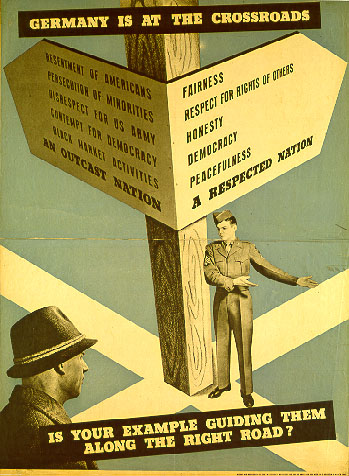DFG Research Project "Regulation of Competition in the Economic Miracle"

© Wikicommons license: https://de.wikipedia.org/wiki/Datei:OMGUS.jpg
Germany was also at a crossroads with regard to competition policy after 1945. The project examines whether - and if so - how the Allies succeeded in overcoming the old German cartel tradition.
This research project examines the practice of antitrust law in the period of the German "economic miracle" in order to re-evaluate the interplay between legal provisions and entrepreneurial practices against the background of the caesura in competition policy after the end of World War II. The scope for action of German companies has been viewed historically almost exclusively in terms of the Act against Restraints of Competition (GWB), which was not passed until 1957. The practice of antitrust law in the immediate postwar period, which was determined by occupation law and rulings of German courts, has not been comprehensively studied. The project fills this research gap in pursuit of a threefold objective.
First, the project makes an empirical contribution to the historical interrelationship of law and the economy. The competition policy forced by the Allies met with resistance not only in public protests but also in the everyday practices of businesses. The legal conflicts forced the courts to interpret the Allied provisions in a way that defined their content. The project is able to show that German companies were partially successful in enforcing their arguments, actions, and traditions in court in at least those areas that were not regulated by per-se rules. Moreover, it makes clear that Allied decartelization policy was by no means uniform or even clearly determined. Rather, there were disagreements both among the occupying powers and within the U.S. Commission. In this context, the influence of the "trustbusters" diminished over time, so that decartelization measures were implemented only sporadically.
Second, the project examines the different views of the German judiciary in the transition to a modern market economy. While some state and higher regional courts adopted a view corresponding to U.S. competition norms in their jurisprudence on vertical price maintenance, large sections of the judiciary, and in particular the Federal Court of Justice (BGH), oriented themselves as far as possible to traditional German principles of interpretation.
Third, the project provides a previously unconsidered explanatory approach to the question of which factors determined the specific design of the GWB. Historical research has mainly considered the influence of the U.S., the role of economic ideas, or the interests of German heavy industry. The project is able to show that the interplay of case law oriented toward new laws and entrepreneurial dynamism shaped by the "economic miracle" led to the establishment of a cartel practice as early as the 1950s that hardly shows the caesura of 1957 marked by the GWB as a break. It also played a role that it was primarily the "losers" among the companies who clung to the old antitrust policy.
A database of legal cases prior to the entry into force of the GWB was created for the project and can be downloaded [here].
A description of the database can be found [here].
- Project Editor: Raphael Hennecke
- Project Management: Prof. Dr. Sebastian Teupe
Link to the DFG project page (project number 388105383)
